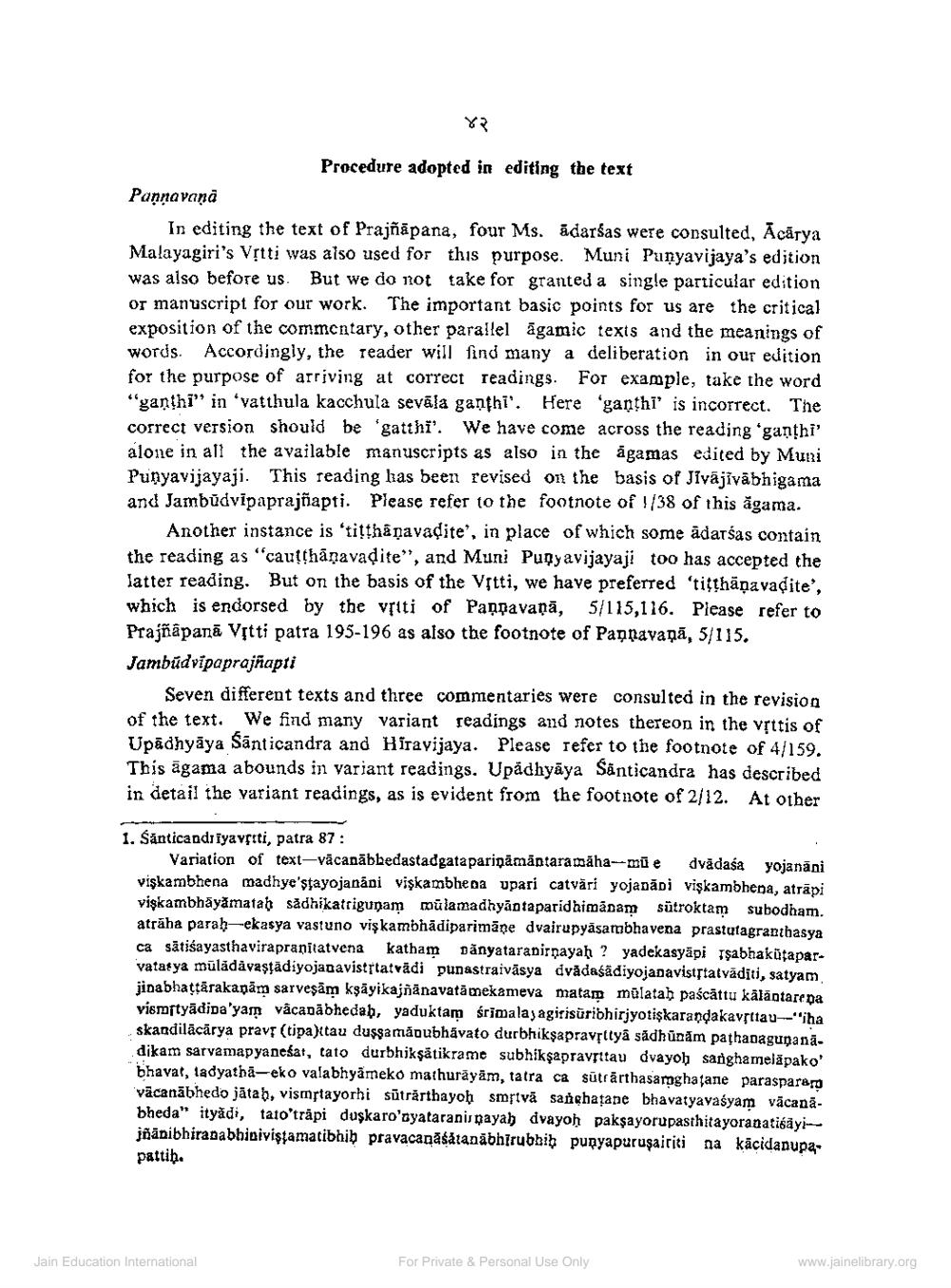________________
Procedure adopted in editing the text Pannavana
In editing the text of Prajñāpana, four Ms. ādarśas were consulted, Ācārya Malayagiri's Vitti was also used for this purpose. Muni Punyavijaya's edition was also before us. But we do not take for granted a single particular edition or manuscript for our work. The important basic points for us are the critical exposition of the commentary, other parallel ägamic texts and the meanings of words. Accordingly, the reader will find many a deliberation in our edition for the purpose of arriving at correct readings. For example, take the word "ganthi" in 'vatthula kacchula sevāla ganthi'. Here 'ganthi' is incorrect. The correct version should be 'gatthi'. We have come across the reading 'ganthi' alone in all the available manuscripts as also in the agamas edited by Muni Punyavjjayaji. This reading has been revised on the basis of Jivājivābhigama and Jambūdvipaprajñapti. Please refer to the footnote of 1/38 of this ăgama.
Another instance is 'titthāpavadite', in place of which some adarśas contain the reading as "cau(thānavadite", and Muni Punyavijayaji too has accepted the latter reading. But on the basis of the Vstti, we have preferred 'titthāņavaçite', which is endorsed by the vsiti of Paņpavaņā, 5/115,116. Please refer to Prajñāpanā Vịtti patra 195-196 as also the footnote of Pannavaņā, 5/115. Jambūdvipaprajñapti
Seven different texts and three commentaries were consulted in the revision of the text. We find many variant readings and notes thereon in the vșttis of Upadhyāya Sānticandra and Hiravijaya. Please refer to the footnote of 4/159. This agama abounds in variant readings. Upadhyāya Sänticandra has described in detail the variant readings, as is evident from the footnote of 2/12. At other
1. Sánticandi iyavşti, patra 87:
Variation of text-vacanābbedastadgatapariņāmāptaramāha--müe dvadasa yojanāni viskambhena madhye'stayojanāni viskambheda upari catvári yojanādi viskambhepa, atrāpi viskambhāyāmatan sădhikatriguņam mūlamadhyāntaparidhimādam sūtroktam subodham. atráha parah-ekasya vastuno viskambhādiparimāne dvairupyāsambhavena prastutagranthasya ca sàtisayasthavirapranitatvena katham Dânyataranirnayah ? yadekasyäpi Isabhakütaparvatarya müladavaştādiyojaoavistftatvadi punastraivāsya dvădaśädiyojanaviststatvaditi, satyam jidabhattarakanām sarvesäm ksāyikajnänavatāmekameva matam mülatah paścăttu käläotarena vismftyādida'ya vāca ābhedah, yaduktam śrimalayagirisüribhirjyotiskarandakavsttau--"'ha skandilācārya pravi (tipa tau dussamădubhávato durbhikṣapravsityā sādhūnām pathanagunanadikam sarvamapyanesat, tato durbhiksātikrame subhiksapravsttau dvayoh sanghamelåpako' bhavat, ladyatha-eko valabhyameko mathurāyām, tatra ca sütrarthasamghatane parasparero vācanăbhedo jätab, vismstayorhi sūtrarthayoh smrtvà sanghagane bhavatyavaśyam väcană. bheda" ityădi, tato trapi duşkaro'ayataranis payah dvayoh pakşayorupasthitayoranatisãy jõāpibhiranabbiniviştamatibhih pravacanăśátanābhirubhiḥ punyapuruşairiti na kācidanupa. pattih.
Jain Education International
For Private & Personal Use Only
www.jainelibrary.org




